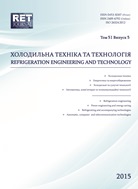HEAT PUMP TECHNOLOGY – POTENTIAL IMPACT ON ENERGY EFFICIENCY PROBLEM AND CLIMATE ACTION GOALS WITHIN UKRAINIAN ENERGY SECTOR
DOI:
https://doi.org/10.15673/0453-8307.6/2015.44781Keywords:
new energy sources, heat pump, natural refrigerant, discharge temperature, coefficient of performance, ground source heat pumpAbstract
The increasing demand of energy sources for urban, household and industrial facilities requires strategies development for seeking new energy sources. In recent years an important problem is to have energy storage, energy production and energy consumption which fulfill the environment friendly expectations. A lot of attention is devoted to renewable energy sources. One of the most attracting among them is energy production form geothermal sources. At a few meters below the earth’s surface the underground maintains a constant temperature in an approximation through the year allowing to withdraw heat in winter for heating needs and to surrender heat during summer for air-conditioning purposes. Heat pump is a rapidly developing technology for heating and domestic hot water production. Using ground as a heat source, heat exchange is carried out with heat pumps compound to vertical ground heat exchanger tubes that allows the heating and cooling of the buildings utilizing a single unit installation. Heat pump unit provides a high degree of productivity with moderate electric power consumption. In this paper a theoretical performance study of a vapor compression heat pump system with various natural and synthetic refrigerants (HFCs) is presented. Operation mode of the heat pump unit was chosen according to European Standard EN14511-2:2007 and EN255-2. An influence of discharge temperature on system performance was evaluated at different boiling temperatures. The comparison of mass flow rate and coefficient of performance for considered refrigerants at constant cooling capacity and condensation temperature was performed.References
Jyoti Soni, R.C. Gupta Exergy Analysis of Vapour Compression Refrigeration System with Using R-407C and R-410A//International Journal of Engineering Research & Technology (IJERT), Vol. 1 Issue 7, September - 2012.
Rotchana N. Prapainop, K. Suen O. Effects of refrigerant properties on refrigerant performance comparison: A review / International Journal of Engineering Research and Applications (IJERA)// Vol. 2, Issue 4, July-August 2012, pp.486-493
Devotta, S. Alternative heat pump working fluids to CFCs. Heat Recovery Systems and CHP, 1995. 15(3): p. 273-279.
Lee, H., J. Yoon, Kim, P.K. and Bansal I, Characteristics of condensing and evaporating heat transfer using hydrocarbon refrigerants. Applied Thermal Engineering, 2006. 26: p. 1054-1062.
Rajapaksha, L., Performance evaluation of reversible heat pumps when using refrigerant mixtures. 2003, University College London: London
Granryd, E., Hydrocarbons as refrigerants, an overview. International Journal of Refrigeration, 2001. 24(1): p.15-24.
UNEP. Handbook for the Montreal Protocol on Substances that Deplete the Ozone Layer. 2006
[cited;: [Available from: http://ozone.unep.org/ Publications /MP_Handbook/index.shtml.]
Wen, M. and Ho C. Evaporation heat transfer and pressure drop characteristics of R290 (propane), R600 (butane) and a mixture of R290/R600 in the three-lines serpentine small-tube bank. Applied Thermal Engineering, 2005. 25: p. 2921-2936.
Gosney, W.B., Principles of refrigeration. 1982, Cambridge: Cambridge University Press.
Woollatt, D. Estimating valve losses when dynamic effects are important. Proceeding of Purdue compressor technology conference 1982: Purdue university
Goetzler W., Zogg R., Lisle H., Burgos J. Ground‐Source Heat Pumps: Overview of Market Status, Barriers to Adoption, and Options for Overcoming Barriers. 2009, - Navigant Consulting, Inc. – 14-18 p.
Angelino L., Dumas P., Latham A. EGEC Market Report Update December 2014. European Geothermal Energy Council. – 2014. 24p.
GROUND-REACH. Inventory of EU Legislation on Ground Coupled Heat Pumps (GCHPs). 2008. – 164p.
EUROPEAN STANDARD NBN EN 14511-2 (2008), Air conditioners, liquid chilling packages and heat pumps with electrically driven compressors for space heating and cooling – Part 2: Test conditions, approved by CEN on 12 October 2007
Final Report IEA HPP Annex 28. Test procedure and seasonal performance calculation for residential heat pumps with combined space and domestic hot water heating. 2005. – 114p.
Winandy, Eric and Hundy, Guy, "Refrigerant and Scroll Compressor Options for Best Performance of Various European Heat Pump Configurations" (2008). International Refrigeration and Air Conditioning Conference. Paper 895. http://docs.lib.purdue.edu/iracc/895
Kharseh M. Ground-Source Heat Pumps and Energy Saving, Heat Exchangers - Basics Design Applications, 2012. – Dr. Jovan Mitrovic (Ed.), ISBN: 978-953-51-0278-6, InTech, 459-476p. Available from:http://www.intechopen.com/books/heat-exchangers-basics-design-applications/ground-source-heat-pumpsand-energy-saving


